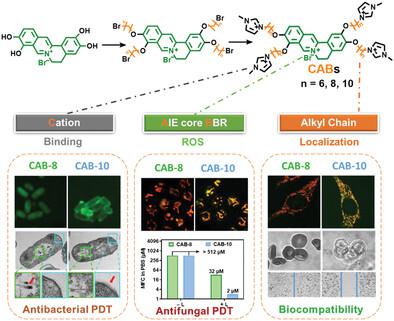当前位置:
X-MOL 学术
›
Adv. Mater.
›
论文详情
Our official English website, www.x-mol.net, welcomes your feedback! (Note: you will need to create a separate account there.)
Flexible Modulation of Cellular Activities with Cationic Photosensitizers: Insights of Alkyl Chain Length on Reactive Oxygen Species Antimicrobial Mechanisms
Advanced Materials ( IF 29.4 ) Pub Date : 2023-05-25 , DOI: 10.1002/adma.202302943 Liang Zheng 1 , Yiwen Zhu 1 , Yujie Sun 1 , Shuai Xia 2 , Shun Duan 1 , Bingran Yu 1 , Jing Li 2 , Fu-Jian Xu 1
Advanced Materials ( IF 29.4 ) Pub Date : 2023-05-25 , DOI: 10.1002/adma.202302943 Liang Zheng 1 , Yiwen Zhu 1 , Yujie Sun 1 , Shuai Xia 2 , Shun Duan 1 , Bingran Yu 1 , Jing Li 2 , Fu-Jian Xu 1
Affiliation

|
Cationic photosensitizers have good binding ability with negatively charged bacteria and fungi, exhibiting broad applications potential in antimicrobial photodynamic therapy (aPDT). However, cationic photosensitizers often display unsatisfactory transkingdom selectivity between mammalian cells and pathogens, especially for eukaryotic fungi. It is unclear which biomolecular sites are more efficient for photodynamic damage, owing to the lack of systematic research with the same photosensitizer system. Herein, a series of cationic aggregation-induced emission (AIE) derivatives (CABs) (using berberine (BBR) as the photosensitizers core) with different length alkyl chains are successfully designed and synthesized for flexible modulation of cellular activities. The BBR core can efficiently produce reactive oxygen species (ROS) and achieve high-performance aPDT . Through the precise regulation of alkyl chain length, different bindings, localizations, and photodynamic killing effects of CABs are achieved and investigated systematically among bacteria, fungi, and mammalian cells. It is found that intracellular active substances, not membranes, are more efficient damage sites of aPDT. Moderate length alkyl chains enable CABs to effectively kill Gram-negative bacteria and fungi with light, while still maintaining excellent mammalian cell and blood compatibility. This study is expected to provide systematic theoretical and strategic research guidance for the construction of high-performance cationic photosensitizers with good transkingdom selectivity.
中文翻译:

用阳离子光敏剂灵活调节细胞活性:烷基链长度对活性氧抗菌机制的见解
阳离子光敏剂与带负电的细菌和真菌具有良好的结合能力,在抗菌光动力疗法(aPDT)中表现出广泛的应用潜力。然而,阳离子光敏剂在哺乳动物细胞和病原体之间通常表现出不令人满意的跨界选择性,特别是对于真核真菌。由于缺乏对相同光敏剂系统的系统研究,尚不清楚哪些生物分子位点对光动力损伤更有效。在此,成功设计并合成了一系列具有不同长度烷基链的阳离子聚集诱导发射(AIE)衍生物(CAB)(以小檗碱(BBR)为光敏剂核心),用于灵活调节细胞活动。BBR核心可以高效产生活性氧(ROS)并实现高性能aPDT。通过烷基链长度的精确调节,CAB 的不同结合、定位和光动力杀伤作用得以实现,并在细菌、真菌和哺乳动物细胞中进行了系统研究。研究发现细胞内活性物质而非细胞膜是aPDT更有效的损伤位点。中等长度的烷基链使 CAB 能够利用光有效杀死革兰氏阴性细菌和真菌,同时仍保持出色的哺乳动物细胞和血液相容性。该研究有望为构建具有良好跨界选择性的高性能阳离子光敏剂提供系统的理论和战略研究指导。
更新日期:2023-05-25
中文翻译:

用阳离子光敏剂灵活调节细胞活性:烷基链长度对活性氧抗菌机制的见解
阳离子光敏剂与带负电的细菌和真菌具有良好的结合能力,在抗菌光动力疗法(aPDT)中表现出广泛的应用潜力。然而,阳离子光敏剂在哺乳动物细胞和病原体之间通常表现出不令人满意的跨界选择性,特别是对于真核真菌。由于缺乏对相同光敏剂系统的系统研究,尚不清楚哪些生物分子位点对光动力损伤更有效。在此,成功设计并合成了一系列具有不同长度烷基链的阳离子聚集诱导发射(AIE)衍生物(CAB)(以小檗碱(BBR)为光敏剂核心),用于灵活调节细胞活动。BBR核心可以高效产生活性氧(ROS)并实现高性能aPDT。通过烷基链长度的精确调节,CAB 的不同结合、定位和光动力杀伤作用得以实现,并在细菌、真菌和哺乳动物细胞中进行了系统研究。研究发现细胞内活性物质而非细胞膜是aPDT更有效的损伤位点。中等长度的烷基链使 CAB 能够利用光有效杀死革兰氏阴性细菌和真菌,同时仍保持出色的哺乳动物细胞和血液相容性。该研究有望为构建具有良好跨界选择性的高性能阳离子光敏剂提供系统的理论和战略研究指导。


























 京公网安备 11010802027423号
京公网安备 11010802027423号